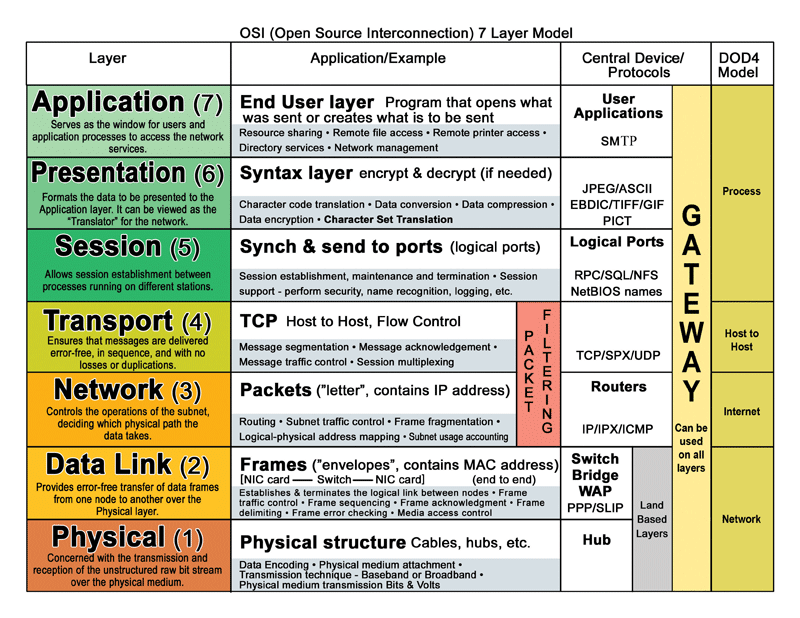Computer Networks - The OSI Model
7 Layers of OSI
https://github.com/ByteByteGoHq/system-design-101?tab=readme-ov-file#tcpip-encapsulation
Aap trans network datalink physical
- Application
- Presentation
- Session –> Behavioural The above three can be clubbed into Application protocol layer due to too much of fine grained details
- Transport –> Routing
- Network –> Routing
- DataLink –> Routing
- Physical
Physical Layer Adds the Start and End delimiter for a message

The NIC and the MAC Address
An NIC (Network Interface Card) is a hardware component that allows computers to connect to a network.
- both wired (Ethernet) and wireless (Wi-Fi) networks
An NIC has a MAC (Media Access Control) address.
- It is a 48-bit address represented. Six groups of two hexadecimal digits separated by colons (e.g., 00:1A:2B:3C:4D:5E).
- The MAC address is used at the data link layer of the OSI model to ensure that data packets are delivered to the correct destination on a local network.
- The MAC address is that of the router in the next hop, not the source adn destination computers -
To route the message to the correct device we need both IP Address and
MAC Address
] 4. Transport
Routing ] 5. Network
] 6. DataLink
DNS : IP Address to Website/business domain name address mapping
Internet Backbone - DNS
NAT : Network Address Translation Protocol
HTTP - Build over TCP
- Guaranteed Delivery
- Client server model - One sends, one receives
Websockets - Peer-To-Peer
- Build over TCS
- bi-directional communication
- It allows for Peer-to-Peer communication.
- It establishes a duplex connection allowing both devices to send and receive requests
- possible to open a two-way interactive communication session
- XMPP (Extensible Messaging and Presence Protocol) which is an open XMLTechnology for real-time communication.
UDP : User Datagram Protocol
- Time sensitive transmissions
- Realtime delivery
- No ACK
- Details
TCP
- Guaranteed Delivery
- Ordering of messages
- Retries upon failures
+-------------------------------+
| 7. Application Layer |
| - Data: Message |
| - Header: Application Header |
| - Provides network services |
| - Protocols: HTTP, FTP, SMTP |
|-------------------------------|
| HTTP Header + Data |
+-------------------------------+
| 6. Presentation Layer |
| - Data: Encrypted Message |
| - Header: Presentation Header |
| - Data translation, encryption,|
| compression |
+-------------------------------+
| 5. Session Layer |
| - Data: Encrypted Message |
| - Header: Session Header |
| - Session establishment |
| - Management and termination |
+-------------------------------+
| 4. Transport Layer |
| - Data: Segment (TCP) |
| Datagram (UDP) |
| - Header: Transport Header |
| - Reliable data transfer |
| - Protocols: TCP, UDP |
|-------------------------------|
| TCP Header + HTTP Header + |
| Data |
+-------------------------------+
| 3. Network Layer |
| - Data: Packet |
| - Header: Network Header |
| - Logical addressing, routing |
| - Protocol: IP |
|-------------------------------|
| IP Header + TCP Header + |
| HTTP Header + Data |
+-------------------------------+
| 2. Data Link Layer |
| - Data: Frame |
| - Header: Data Link Header |
| - Trailer: Data Link Trailer |
| - Node-to-node data transfer |
| - Error detection/correction |
| - MAC addresses |
|-------------------------------|
| MAC Header + IP Header + |
| TCP Header + HTTP Header + |
| Data |
+-------------------------------+
| 1. Physical Layer |
| - Data: Bits |
| - Media: Electrical signals, |
| light pulses, radio waves |
| - Transmission of raw bits |
| - Media, signal, and binary |
| transmission |
|-------------------------------|
| 10010111... |
+-------------------------------+